Protein, vegetables, fruit, grains, and dairy.
With that simple philosophy, the U.S. Government unveiled their new “MyPlate” earlier this year.
State-sanctioned dietary recommendations go back decades, and they have an inherent authority about them. They are claimed to be backed up by current scientific research and have an undeniable impact on the way people eat.
But should we automatically follow the government’s suggestions without question?
Perhaps more importantly, is it even their responsibility to give us guidance on the “right” diet?
Government Recommendations Throughout the Years
First off, a quick history lesson.
The early food suggestions didn’t attempt to describe the total diet, but rather point out important foods that should be eaten every day.
The first of these guides, 1894’s Principles of Nutrition and Nutritive Value of Food, was a comprehensive and complex look at the nutritional needs of humans and how to best meet them as economically as possible. This report came out before the discovery of vitamins and minerals and thus focuses primarily on the calorie, fat, carbohydrate, and protein content of food.
The concept of “food groups,” although a relatively intuitive concept, was first classified in the USDA’s 1916 guide Food for Young Children, which broke food up into the following categories:
- Milk and meat
- Cereals
- Fruits and vegetables
- Fats and fatty foods
- Sugars and sugary foods
One year later, the USDA released How to Select Foods. This guide utilized the five food groups described earlier as a way to help families determine what and how much food they should be buying and eating.
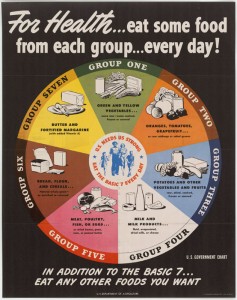 Dialing things up a bit, the USDA introduced the “Basic Seven” in 1943, suggesting everyone eat at least one thing from each group every day, which were as follows:
Dialing things up a bit, the USDA introduced the “Basic Seven” in 1943, suggesting everyone eat at least one thing from each group every day, which were as follows:
- Milk and milk products
- Meat, poultry, fish, eggs, beans, peas, and nuts
- Bread, flour, and cereals
- Leafy green and yellow vegetables
- Potatoes and sweet potatoes
- Citrus, tomato, cabbage, salad greens
- Butter, fortified margarine
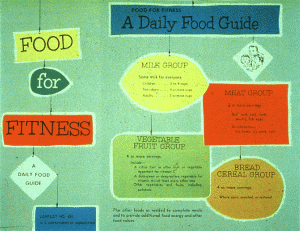 The complexity and difficulty of use of this guide led to the government’s “Basic Four” in 1956, taking one step forward in reducing the number of food groups (vegetables and fruits, milk, meat, grains and cereals), but one giant step backwards in introducing the concept of “serving sizes.”
The complexity and difficulty of use of this guide led to the government’s “Basic Four” in 1956, taking one step forward in reducing the number of food groups (vegetables and fruits, milk, meat, grains and cereals), but one giant step backwards in introducing the concept of “serving sizes.”
 The Hassle-Free Daily Food Guide was released in 1979, two years after George McGovern’s infamous report damning fat in the diet and suggesting we start to restrict it. This chart introduced a fifth food group, consisting of fats, sugars, and alcohol, which were to be consumed only in small amounts.
The Hassle-Free Daily Food Guide was released in 1979, two years after George McGovern’s infamous report damning fat in the diet and suggesting we start to restrict it. This chart introduced a fifth food group, consisting of fats, sugars, and alcohol, which were to be consumed only in small amounts.
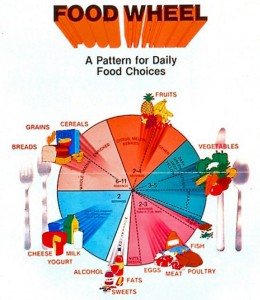 The American Red Cross partnered with the USDA for 1984’s Food Wheel, which was first published in A Pattern for Healthy Daily Food Choices. For the first time, the USDA had put together a guide that was meant to cover the totality of the diet, not just covering the foods you should be eating every day, but also those that you should avoid as much as possible. The Food Wheel was made even more complex by attempting to cover three different calorie intake levels.
The American Red Cross partnered with the USDA for 1984’s Food Wheel, which was first published in A Pattern for Healthy Daily Food Choices. For the first time, the USDA had put together a guide that was meant to cover the totality of the diet, not just covering the foods you should be eating every day, but also those that you should avoid as much as possible. The Food Wheel was made even more complex by attempting to cover three different calorie intake levels.
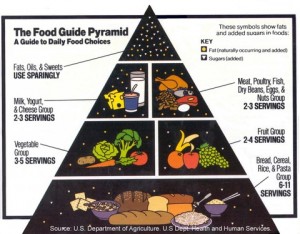 1992’s Food Guide Pyramid is what I remember from my childhood. The USDA basically took the Food Wheel (which was not well-known to the public), altered the design into a pyramid, and began a huge push to get it in front of as many Americans as much as possible. It proved to be a great success and the Food Pyramid was successfully promoted for years afterwards.
1992’s Food Guide Pyramid is what I remember from my childhood. The USDA basically took the Food Wheel (which was not well-known to the public), altered the design into a pyramid, and began a huge push to get it in front of as many Americans as much as possible. It proved to be a great success and the Food Pyramid was successfully promoted for years afterwards.
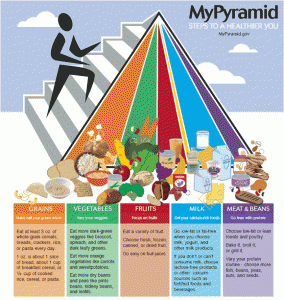 The MyPyramid food system was released in 2005. Although it was introduced as a simplification of the previous pyramid, to me it looked like a mess. How is anyone supposed to figure out any practical information from a rainbow-colored pyramid that a stick figure is walking up?
The MyPyramid food system was released in 2005. Although it was introduced as a simplification of the previous pyramid, to me it looked like a mess. How is anyone supposed to figure out any practical information from a rainbow-colored pyramid that a stick figure is walking up?
MyPlate: The Good, the Bad, and the Ugly
Which brings us to 2011 and the USDA’s most recent healthy eating infographic: MyPlate.
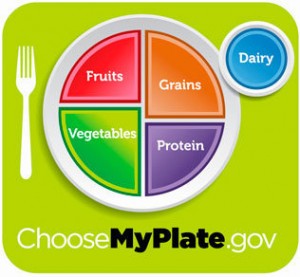 And I’m not gonna lie… I kinda like it. Sure I have all the same beefs with the government’s advice as I always do (more on that later). But after more than thirty years of ever-increasing complexity in their advice, it’s nice to see that they have finally turned something out again that is simple. (Here’s the official website, if you’d like to check it out more in-depth.)
And I’m not gonna lie… I kinda like it. Sure I have all the same beefs with the government’s advice as I always do (more on that later). But after more than thirty years of ever-increasing complexity in their advice, it’s nice to see that they have finally turned something out again that is simple. (Here’s the official website, if you’d like to check it out more in-depth.)
Nutrition is an extremely complex thing, and the tendency is always to add more and more to it until it becomes an incomprehensible mess. By simplifying things, you miss out on a lot of the subtle nuances, sure, but you end up with something that people can realistically use, which trumps all that other crap in my book.
Counting calories? Waste of time. Limiting your serving sizes? Goes against nature and is detrimental to your health.
Instead, we’re left with a simple picture: protein, vegetables, grains, and fruit, in almost equal portions, and a glass of milk. It’s simple enough for a grade-school child to instantly understand, which is what they should have been going for all along.
But now we come to the bad part.
First up is the focus on nutritionism, most evident in the “protein” section of the plate. WTF? Grains, vegetables, and fruits are all pretty obvious food groups, but protein is a macronutrient that is found in damn near everything.
My fear is that this is there to imply “lean protein,” or protein sources that are as devoid of fat as possible. (Bring on the boneless, skinless chicken breasts!) How about a section of the plate that just says “meat?” Unfortunately, the government is still firmly entrenched in all the low-fat B.S. they started back in the 70’s, and it ain’t gonna change any time soon. But you shouldn’t feel bad about getting your protein from beef, pork, or any other fatty meat.
Of course, you could get your protein from beans and rice as well. Meh. While this might be a decent choice for college students and others really in a pinch, they don’t call these “third-world proteins” for nothing. Sure, you can survive on it. You might even do quite well with it. But never as good as if you add at least a little bit of meat into the mix.
The nutritionism is also implied in the “dairy” section on the side. Is there anyone who doesn’t think of dairy as simply a “nutrient delivery system” for calcium? I don’t have a big problem with dairy (cheese, cream, and yogurt are all mainstays in my diet), but it’s important to remember that we’ve only been consuming the stuff for the past 10,000 years, and most of the world’s population is still lactose intolerant!
That dairy is somehow a necessary staple in everyone’s diet is dubious at best. There’s ample evidence suggesting that:
- You can get plenty of calcium from sources such as dark, leafy greens and seeds.
- Calcium isn’t as important as vitamin D for healthy bones, which you can get from sunlight.
- Calcium consumption isn’t as important as calcium retention, which means getting your RDA for calcium means nothing if it all ends up getting leached out of your bones and peed out anyway.
- Exercising strengthens your bones.
And then we get to grains. The biggest problem I have with every new set of government nutrition recommendations is the constant push for massive quantities of grains. Here we’ve got a quarter of the plate devoted to grains, which is certainly better than the gargantuan 6-11 servings from the Food Pyramid.
I’m not as hard-line as most of my Paleo brethren when it comes to grains, but really? Like dairy, grains have only been a part of the human diet since the advent of agriculture, a blink of the eye in evolutionary terms and certainly not enough time for us all to have evolved to the point where grains are that big a necessity. Like nearly all plants, grains have inherent mechanisms for deterring predators that affect their health negatively. These anti-nutrients appear to be even more prevalent in grains and legumes. And currently approximately 1% of people are gluten-intolerant, with many more undiagnosed.
But this only hints at what is the biggest problem with all of the USDA’s nutrition advice. The reason you should never take a word of their suggestions to heart…
The Conflict of Interest
The main purpose of the USDA is not to give you sound nutrition advice, but to sell United States agricultural products.
In case you are just blazing through this post, I’ma repeat that again, ‘cuz it’s a doozy.
The main purpose of the USDA is not to give you sound nutrition advice, but to sell United States agricultural products.
Taking your nutrition advice from the agency responsible for selling their food to you is like taking investment advice from a banker. Sure, they’ve got some authority and they probably know more about it than the Average Joe, but at the end of the day, their livelihood is still dependent on you giving them money, and they know it.
MyPlate, just like all other USDA-sponsored nutrition graphics, is more a product of lobbyists for powerful agricultural industries than it is a culmination of scientifically-sound evidence.
In other words, you should take what they say with a huge grain of salt.
It’s Up to You
There’s a lot of conspiracy theorists out there who believe that the government is purposely trying to keep us unhealthy in some sort of weird scheme to keep us sick enough to not notice when they go about their wicked, wicked ways. (Insert evil laugh here.)
Yeah right. While I certainly have my misgivings about the way our country is run sometimes, I’m sure the guys on top realize it’s best to have us as healthy as possible. The better our health is, the more productive we are, the better our country’s GDP is. That’s what it boils down to. Money talks.
Although I’m sure the government wants us to be as healthy as possible, they are doing it in just about the worst way possible. The conflict of interest in the USDA makes everything it puts out instantly suspicious, despite whatever they have backing it up. The confluence of powerful lobby groups and bad science make their recommendations suspicious at best, utterly false at worst.
No matter how purdy that new plate is, there just isn’t enough substance backing it up.
But that brings up an important issue: should you really be relying on the government to get you healthy?
I suppose I could do the democratic thing and circulate petitions, write my congressman, and take to the streets with pamphlets and catchy chants to try and get the government to alter their nutrition guidelines to something that is more likely to be successful for the majority of people… but I’m not.
I’d rather take it directly to the people. And encourage you to take control.
You shouldn’t expect the government to keep you healthy. You shouldn’t blame your parents for feeding you junk food as a kid. You shouldn’t blame your employer for giving you $20 credit to the candy machine every two weeks. This is your skin in the game. And nobody cares more than you do.
So educate yourself about nutrition, exercise, and rest. Learn what the human body has traditionally needed to do in order to thrive. Learn how to cook a few decent meals. Learn how to work out as little as possible, focusing on what works while getting excellent results, so that you can deal with the things in your life that are more important. Learn how to sleep better. Learn how to have fun more often. Learn how to follow your bliss. Track your progress so you see what works and what doesn’t. And always keep challenging yourself.
It might be a pain in the ass to not have to rely on someone, but it will pay huge dividends.
As for me, my plate consists of a shit-ton of meat and vegetables. The more the merrier. And just enough red wine to enjoy life a little without going overboard into Hunter S. Thompson territory.

I wouldn’t have it any other way.
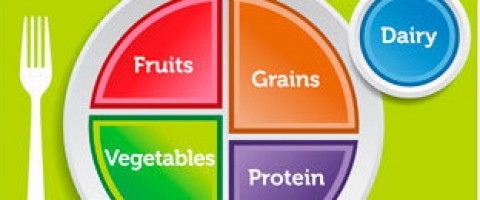
 I'm a science geek, food lover, and wannabe surfer.
I'm a science geek, food lover, and wannabe surfer.
{ 12 comments }
Actually counting calories works for all people and I discovered it is the simplest method for most people to understand. People need something to measure. “Eat real, live food” doesn’t speak to them. You can eat unhealthy but less calories and you will lose weight. When people want to change their eating habits they don’t think about their health but about their weight and watching portion size and counting calories is something they understand. Then on second stage they start to see difference in food quality and understand recommendations that don’t involve math.
@Rumiana
The problem I have with calorie-counting is that it fails in practice at what it should do in theory. For instance, the average guy needs an accuracy of 0.4% at calorie-counting if he’s going to be within 1 lb of his target weight in a year, and 4% if he wants to be within 10 lbs. But calorie counts of foods have been found to be 8-18% higher than their published values.
That the strictest calorie-counters aren’t gaining lots of weight each year suggests that there’s something else going on here. People may or may not lose weight, but it turns out the quantitative analysis of calorie-counting is too inaccurate to consistently lead to desired results. As a short-term strategy, creating a qualitative calorie deficit through near-starvation and constant exercise might be viable, though I’d recommend against it for long-term use due to the overall health risks.
I’ve struggled with counting calories over the years and have found it to be a source of immense frustration and burnout. I’ve found that focusing on QUALITY of food rather than QUANTITY is a “big win” that conserves a lot of my willpower. I absolutely agree with you that people need to measure something, but I’d rather see them measure the “end product” and take pictures, weight, BMI, body fat %, and measurements of shoulders, waist, and hips.
Thanks for your comment!
Great analysis. Very intelligent and truthful. I was actually happy to see a no bs approach to a completely bs attempt at making healthy food recommendations haha.
@Darrin, it took you years to understand there is better approach. And I think the long path you walked makes you think what you think today. People learn from mistakes and also our clients too. I teach my clients about calorie value of food and to count calories and gradually they start to get the difference between food. For example they don’t know that 100 gr. of oil is 800 calories and 100 gr. of meat/fish is under 100 calories. Once they learn this, they start to make better choices. And after some years they come where you are 🙂
@Ahmed
No Doubt. Thanks man!
@Rumiana
Haha. I definitely think of myself more as a guy “down in the trenches” with everyone else trying to make all this stuff work for me than the kind of person people should aspire to be like after a few years, but thanks! 🙂 I just think there are more effective ways of going about all this than we have been led to believe, and I’d love to help as many people as possible shave off some time and effort from the “learning curve.”
Great analysis here. I never really thought about the government’s motivations although they are becoming a lot more involved in people’s health lately. Look at Michelle Obama’s obesity initiatives and you can see that it’s a problem the government is trying to solve. Unfortunately, trying to force beliefs and rules on people never seems to lead to weight loss. If someone tells me not to eat something, I’m probably more likely to eat it! I think ultimately everyone needs to find a system that works for them. Some diets make sense to certain groups but not others…look at the paleo diet, recently voted last in a survey of diets by nutritionalist, doctors, etc. Most people I know that follow a paleo approach swear by its effectiveness though. Overall, a lot of confusion and lack of information increase the challenge. Each experience can only help to shape the next. My plate includes meat, veggies, and fruit with a side of dessert from time to time (in moderation).
@Dave
Haha. I’m the same way. Tell me not to do something and I want to do it all the more! Still a stubborn only child, I guess. Although I can appreciate broad-based initiatives to improve our health, I believe it is still ultimately up to us as individuals to take responsibility and employ some critical thinking.
I saw that U.S. News ranking of diets as well. The best part about it was that it let people vote on whether each of those twenty diets worked for them or not, and guess what? Only the last place diet (Paleo), second-to-last place diet (Atkins), and second place diet (Weight Watchers) had more people voting “it worked” than “it didn’t work.” Hmmm… something’s wrong here! When it comes to the effectiveness of different diets, practice trumps theory every time.
The government seems to always have alternative motives when doing something. Even when you want to believe they are really trying to help it just doesn’t come across right.
Weightloss has become something people feel that need to become scientists about when in fact is just eat less, choose better foods, and be active. There are some many DIETS that is just drives people crazy! And no one is actually saying the same as the next they all want to be Different.
I also blame us as people in always wanting to take the easy way out. There is not secret pill or ab exercise that is going to help you get rid of fat. But too often if you make it seem easy people will buy it just because and those of us who give great info get looked at as the bad guys or people who don’t know what they are talking about.
Arrhhh this is all to impossible to think about when I’m eating … I guess I do what I’ve always done and listen to myself, look in the mirror and if I like what I see that’s it…. all these rules just give me a stomach ache! …haha well seriously I guess it’s good.
I wish they showed the portions to be a lot smaller ( or inversely a large plate) so they remind people not to eat so much and not give the impression of filling up the plate.
I’m not scared of grains I eat them every day as dairy but this does show too much grains compared to other food groups.
Nice dissertation on the food myplate!
Raymond
Darrin,
I personally don’t think we should rely on the government to tell us what we should eat. We need to take responsibility for our own health and control our own diets. Until this year, it seems like the 1992 food pyramid had been around forever and we all know that it’s pretty much a joke. If everyone ate that many grain-based carbs, we’d all be obese… oh wait. I think that’s what’s happened. If we should follow any type of “food diagram” I believe Mark Sisson’s Primal food pyramid is the best model.
Alykhan
Brilliant post dude.
It’s amazing how much and how often the recommendations change……almost as though they aren’t quite as sure about it as a lot of people think they are.
I totally agree though, the best way is to take responsibility yourself. You’ll get to your goals faster and you won’t have to dance to someone else’s tune.
Michael
@Thomas
I think people definitely get paralyzed into inaction when they have too many choices. I go into this in more detail here, but in almost all cases it’s better to JUST GET STARTED than it is to do a bunch of research to do the “right thing” right off the bat.
@Raymond
Haha. You definitely made a good point in that its important to keep an eye on the mirror and find out what’s working for you. That way you can make your OWN “MyPlate.”
@Alykhan
No kidding. Personal responsibility FTW! 🙂
@Michael
Thanks dude! I”m sure the recommendations are changing in proportion to the amount that lobbyists are pushing them, ha.
Comments on this entry are closed.